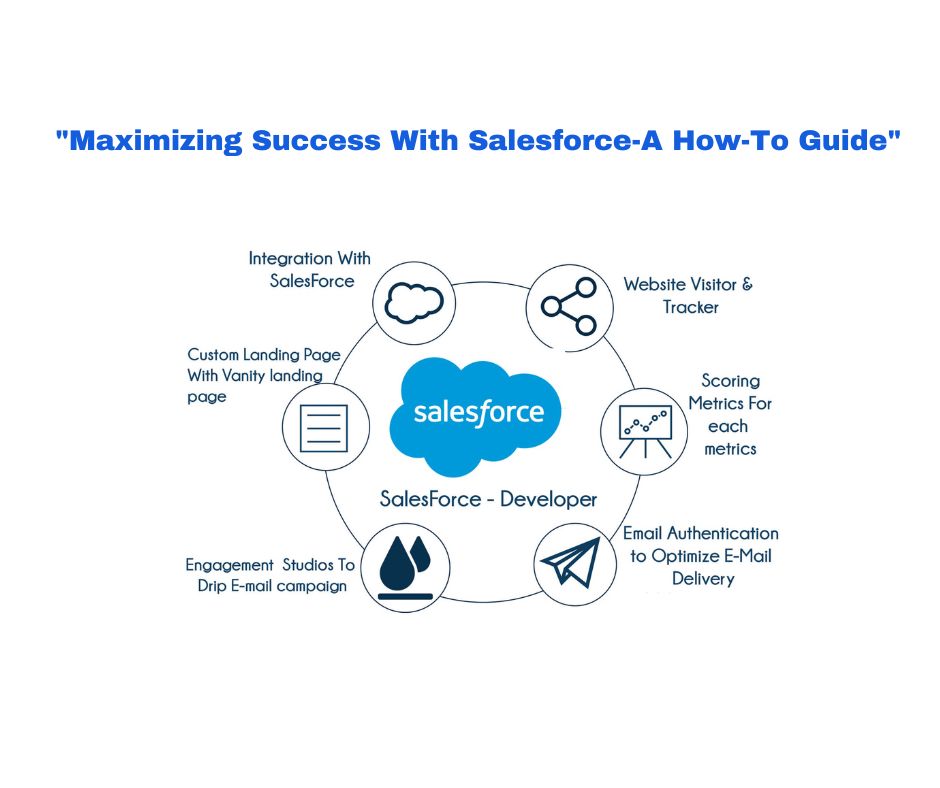“Maximizing Success With Salesforce-A How-To Guide”
5 min read
Last Updated on June 11, 2023 by Jonathan Lopez
Getting Started With Salesforce
Salesforce is a powerful CRM system that can help businesses of all sizes to increase their efficiency and productivity. If you’re new to Salesforce, or you’re looking to take your business to the next level, then this how-to guide is for you. In this section, we’ll outline the basics of Salesforce and how it can help your business. We’ll also teach you how to configure Salesforce for your specific needs, so that it’s optimized for growth.
Once you’ve read through this guide, you’ll understand the basics of Salesforce and be able to configure it for your business objectives. You’ll be able to measure success with user data and identify where improvements can be made in your workflow. You’ll be able to use task delegation tools and Salesforce metadata to define and adjust objects more effectively. And lastly, we’ll introduce you to some of the newest features in Salesforce – AI and automation functions – so that you can take advantage of the platform as it evolves over time.
Finally, we encourage you to connect with the Salesforce community for expert advice on best practice solutions for specific tasks or challenges. By sharing your success stories with others, together we can help everyone achieve greater success with this powerful CRM system!
Essential Steps To Making Salesforce Work For Your Business
Salesforce is an essential tool for businesses of all sizes. It can help you to streamline your sales processes, track your leads and assets, and more. However, it can be tricky to get start and to use Salesforce effectively. In this section, we will outline the essential steps that you need to take in order to maximize your success with Salesforce. The Salesforce Training in Hyderabad course by Kelly Technologies can help you build skills that gets you hired in this cloud domain.
First and foremost, it’s important to understand the basics of Salesforce. This includes understanding how it works, what its features are, and how you can use them best for your business. Once you have a basic understanding of Salesforce, you can begin implementing a strategy for using it effectively. This might include setting up dashboards and reports so that you can obtain actionable insights on data entry processes and business activity overall.
To maximize efficiency in your data entry processes, it’s important to build automation workflows into your Salesforce usage. This will help reduce the amount of time that is spent manually entering data into Sales force objects. Additionally, integrating Sales force with other business applications can provide additional benefits such as consolidating customer information or tracking orders through other systems. Finally, proper training is essential for ensuring that all members of your team are using Salesforce properly and efficiently. Establishing best practices for security along with policies governing user access will also ensure that your data is protecte from unauthorize access or misuse.
Building And Maintaining Database Performance
When it comes to sales, there’s no room for error. If your sales data is slow or difficult to access, you’ll lose out on opportunities and customers will move on to the competitor. In this section, we’ll outline some of the best strategies for optimizing Salesforce performance and maintaining data quality.
First and foremost, it’s important to identify and address technical debt in Salesforce. This means that you need to take stock of how your system is performing right now and make necessary improvements. By addressing technical debt early, you can minimize the impact that it has on overall system performance.
Additionally, it’s important to optimize the user experience with development best practices. This means making sure that all aspects of the user interface are design properly from start to finish so that users have an easy time using your system. It also means ensuring that all code is well-written and error-free so that users have a positive experience when interacting with your application.
Another key factor in Salesforce performance is assessing the cost vs benefit of customization. Sometimes added features or modifications can be more costly than they’re worth in terms of system performance or data quality. When making these decisions, always take into account both short-term and long-term benefits before making any changes or upgrades。.
Finally, let’s discuss some of the tools that are available for automating tasks in Salesforce while reducing database bloat (i.e., unnecessary data stored within Salesforce). These tools include dynamic Apex triggers and Lightning Connect applications. Automation can also be achieve by leveraging native features such as Lightning Processes and Chatter Data Sources。 By using these techniques together, you can achieve optimal performance while minimizing risk associated with custom development work。
Strategies For Upgrading Your Salesforce System
If you’re like most business owners, you’re probably wondering what the best way to use Salesforce is. With over 250 million users worldwide, It is one of the most popular software platforms in existence. In this section, we will walk you through the features of Salesforce and explain some of its benefits. Afterwards, we’ll provide tips on how to prepare for a successful system upgrade and guidelines for optimizing your Salesforce implementation. We’ll also share tips on maintaining ongoing success with your new system.
When it comes to using Salesforce, there’s no one-size-fits-all approach. Every business is different and will require a different mix of features and functionality. That’s why it’s important to take the time to understand exactly what’s available in Salesforce before making a decision about whether or not to use it. In addition, many businesses find that leveraging Salesforce provides significant benefits such as decreased customer acquisition costs (CAC), increased productivity, and increased manageability. So if you’re ready to take your sales efforts up a notch, read on for our guide on how to do just that!
First things first – let’s take a look at some of the key features available in Salesforce:
1) Customer Relationship Management (CRM) – This feature allows businesses to manage their customer relationships from one central location. This makes it easier for businesses to keep track of all interactions with their customers and ensures that all relevant information is accessible at any time.
2) Automated Workflow – This feature allows businesses to automate common sales processes such as lead qualification and follow up calls/emails/etc. This can save time and help ensure that sales tasks are complete quickly and efficiently.
3) Advance Analytics – With advance analytics capabilities such as lead scoring and performance analysis, businesses can track key performance indicators (KPIs) in order not only measure progress but also identify areas where improvement is need.
4) AppExchange – The AppExchange offers businesses access to thousands of pre-built applications which can be used within Salesforce.
This article in the blogstab must have given you a clear idea about key features available in Salesforce, let’s talk about some benefits:
1) Increased Productivity – Many business owners find that using system allows for enhanced productivity when compared with traditional methods such as paper trails or email correspondence.
2) Lower Costs – By automating common sales processes using system solutions, businesses can reduce costs.




